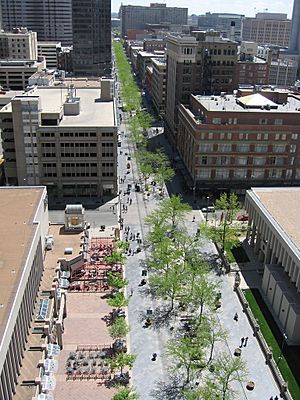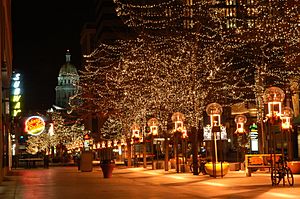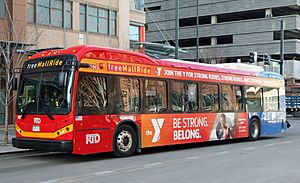16th Street Mall facts for kids

The 16th Street Mall is a fun street in Denver, Colorado. It's a special kind of street where people can walk freely. Buses also travel along it. The mall is about 1.25 miles (2 kilometers) long. It runs through downtown Denver. You can find it from Union Station to the Civic Center Station.
The sidewalks and streets are made of granite stone. A famous architect named I.M. Pei designed them. They look like the pattern on a rattlesnake's skin! The mall has over 300 stores and more than 50 restaurants. It's also home to the Denver Pavilions.
Contents
History of the 16th Street Mall
The 16th Street Mall first opened in 1982. It was designed by a team of experts. These included Pei Cobb Freed & Partners and OLIN. They created a great space for people.
The mall was made longer in 2001 and 2002. This connected it all the way to Union Station. Before 1982, 16th Street was already a busy place. It had many shops and offices. Today, the 16th Street Mall is a central spot. It connects major businesses and fun tourist places.
Street Performers on the Mall
Many talented people perform on the mall. This is called street performing. You can often see musicians playing folk or country music. Dancers, actors, and comedians also perform here. It's a popular place for artists to share their talents.
How to Ride the Free MallRide Bus
A special free bus service runs on the mall. It's called the Free MallRide. The Regional Transportation District (RTD) operates these buses. They help people get around the mall easily.
The first MallRide buses were unique. They were built with the driver's seat on the right side. This helped drivers see people getting on and off. It also helped them watch out for walkers. These buses could go up to 25 miles per hour (40 km/h).
Over the years, the buses have changed. Newer models were designed to be more eco-friendly. They use special hybrid-electric power. These buses have extra doors and more standing room. Drivers still sit on the right side for safety. In 2015, RTD decided to buy all-electric buses. These new buses started running in 2016.
The MallRide stops at every street crossing. It goes between Union Station and Broadway. There are two main stations: Union Station and Civic Center. These stations connect you to other RTD buses and trains. You can connect to many train lines at Union Station. Other train connections are at the 16th/California & 16th/Stout stations.
Besides the MallRide, you can find other ways to travel. There are pedicabs (bike taxis) and horse-drawn carriages. You can also rent bikes or use car-sharing services. Bikes and scooters are not allowed on the mall on weekdays.
The Mall as a Community Space

The 16th Street Mall is a great urban space. It helps people move around downtown. It also gives everyone easy access to Union Station. The mall is successful because of all its shops and restaurants. There are cafes, window displays, and street performers.
Sometimes, the mall hosts special events. These "Meet in the Street" events close parts of the mall to buses. This lets people walk and bike freely. It's a fun way to bring the community together.
Images for kids



